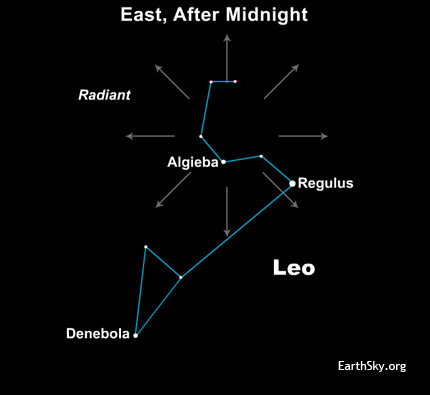Source: EarthSky - 11/16/12

Tonight for November 16, 2012
 Courtesy U.S. Naval Observatory
Courtesy U.S. Naval ObservatoryOur featured chart (top of post) shows the radiant point for the Leonid meteor shower, near the star Algieba in the constellation Leo the Lion. The 2012 Leonid meteor shower is expected to present the greatest number of meteors before dawn on Saturday, November 17. So tonight is your best time to watch! What’s more, Sunday, November 18 may offer a decent sprinkling of meteors as well. If you have a dark sky – far from city lights – you might see as many as 10 to 15 meteors per hour.

The illustration on the right depicts a Leonid meteor storm in the year 1833. It shows what the Leonid shower might look like in a year that this shower erupts into storm, bombarding the sky with thousands of meteors – sometimes also called shooting stars or falling stars – per hour. Will there be a Leonid storm in 2012? That’s one prediction we can make with a fair amount of certainty, and the answer is no. No storm or heightened meteor activity is anticipated for the Leonid meteor shower in 2012. This year’s peak rate will probably be around 10 to 15 meteors per hour.
We see the most Leonid meteors in the dark hour before before dawn because that’s when the constellation Leo the Lion is found highest in the sky. This year, though, there’s another reason why we’ll be seeing more Leonid meteors in the predawn sky: the moon is out of the way. Yay!

The moon and Mars set early on November 16, leaving a dark sky for the Leonid meteors. See more on the November 2012 planet guide

Dazzling Jupiter is up all night now. This chart shows Jupiter in front of the constellation Taurus in early evening.

Before dawn, look for Venus and Saturn in the southeast.
In 2012, the slender waxing crescent moon sets beneath the southwest horizon shortly after nightfall, leaving a dark sky for meteor watching! If you look low in your southwest sky after sunset, you might catch the waxing crescent moon and the planet Mars just before they follow the sun beneath the horizon.
Fortunately, the Leonid shower is peaking this weekend, so why not make a night of it? After the moon and Mars set tonight, look in the opposite direction to watch the dazzling planet Jupiter climbing over the east-northeast horizon. Once Jupiter rises into the evening sky, this brilliant beauty will light up the constellation Taurus the Bull all night long. Then in the dark hour before dawn look for Venus, the sky’s brightest planet, and the fainter planet Saturn shining low in the southeastern sky, in front of the constellation Virgo the Maiden.
Never miss another full moon. Order your 2013 EarthSky moon calendar today! Supplies limited.
Many ask about the radiant points of meteor showers. Please know that you don’t have to locate the radiant point to watch the Leonid shower, for these meteors will fly all through the starry heavens. But it’s fun to know where the radiant lies in the sky. When tracing the paths of the Leonid meteors backward, they appear to radiate from the constellation Leo the Lion. The meteors in this annual shower are named for this constellation. As seen from mid-northern latitudes, Leo rises over eastern horizon around 1 a.m. That’s why you’ll see more meteors after midnight. After rising, Leo then swings upward and westward throughout the morning hours after midnight. It climbs to its highest point in the southern sky around 6 a.m.
Every year – in November – our planet Earth crosses the orbital path of the Comet Tempel-Tuttle. Debris from this comet burns up in the Earth’s upper atmosphere to create the annual Leonid shower. Peak rates are generally around 10 to 15 meteors per hour, but this shower has also been known to create rich meteor storms. No Leonid meteor storm is expected for 2012, however.
Just find a dark sky away from pesky artificial lights, enjoy the comfort of a reclining lawn chair and sleeping bag, and enjoy the 2012 Leonid meteor shower in a moonless sky.

